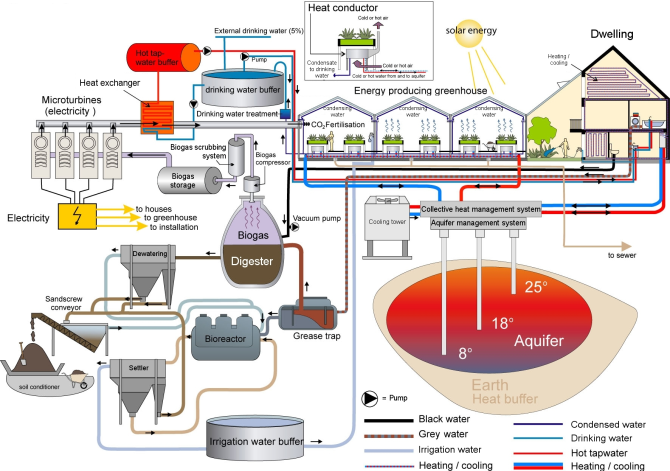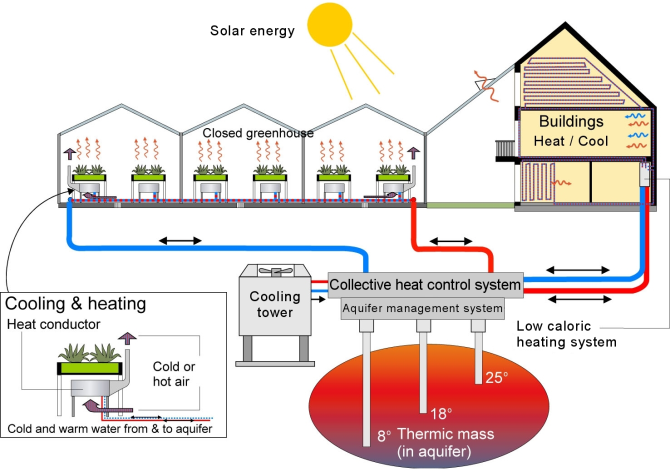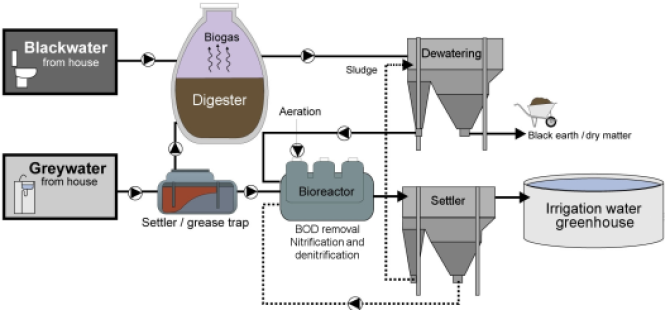
Project
Greenhouse Village – Can we link the resource flows of greenhouses and households?
The Greenhouse village concept aims at largely closed energy-, water and nutrient cycles and high self-sufficiency, which the combined resource cycles of agri-/horticultural greenhouses and residential units are assumed to enable.
Motivation
The Netherlands are renowned for their densely populated urban areas and their skills and knowledge in effective agri- and horticulture as well as food supply including a sophisticated use of greenhouses. While representing a large economic factor, greenhouses and the processes therein are highly water-, energy-, nutrient- and knowledge-intensive. Densely populated areas urban and peri-urban areas all around the world, have to struggle with increasing sustainability issues due to increasing demands and stress on ecosystems as consequences of growing population density while having to preserve the current quality of life.
In scope of this project,we investigate and develop the combination of greenhouses and residual units in one joined concept aiming at closing cycles through implementing greenhouses strategically at district-level. The Greenhouse village concept aims at largely closed energy-, water and nutrient cycles and high self-sufficiency, which the combined resource cycles of agri-/horticultural greenhouses and residential units are assumed to enable. The “Greenhouse Village" concept combines these functions and provides the needed circular urban metabolism.

Overview of possible combined cycles of Greenhouse Village
Idea
The Greenhouse Village concept, based on first conceptual ideas, can potentially lead to a closed resource cycles on a small spatial scale. For instance, domestic waste(water) from connected dwellings can be collected, and treated in such way that water, organics and nutrients will be recovered for use in the greenhouses. On the other hand, greenhouses could provide heating and cooling as well as food and leisure possibilities. Thus residential units become a) direct users for energy streams (with or without storage) and water produced in the greenhouse, and b) provide biogas, recovered nutrients and organics via source-separated sanitation concepts for the operation of the greenhouse.
Core technical elements of the Greenhouse village are a) source-separated sanitation concepts with resource recovery (New Sanitation) and b) an Aquifer Thermal Energy Storage system for heat and cold storage and supply in combination with a highly efficient heat exchanger. While first conceptual ideas exist (Figure 1), knowledge is currently lacking on how far actually the resource cycles can be closed under which boundary conditions, which (newly developed) technologies are optimal at prevailing conditions and how far can production of the greenhouses and the residential unit be aligned to achieve an optimal dynamic equilibrium, e.g. in terms of self-sufficiency or maximum output per greenhouse.

Climate control system of the greenhouse and the housing block

Separate collection and treatment of black and grey water in Greenhouse Village
Future steps
- Stronger focus on the greenhouse / agriculture part of this project
- Extension of knowledge of the involved resource cycles and possible technologies
- Identification of most promising options for a combination of greenhouses and households
- Development and design of a prototype ‘Greenhouse Village’ and integration in the built environment
*All pictures taken Mels, A., et al. (2006). Greenhouse village, the greenhouse-powered, self-sufficient neighbourhood. Proceedings of International conference on Asia-European Sustainable Urban Development, Chongqing University.